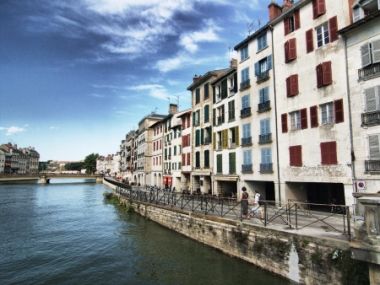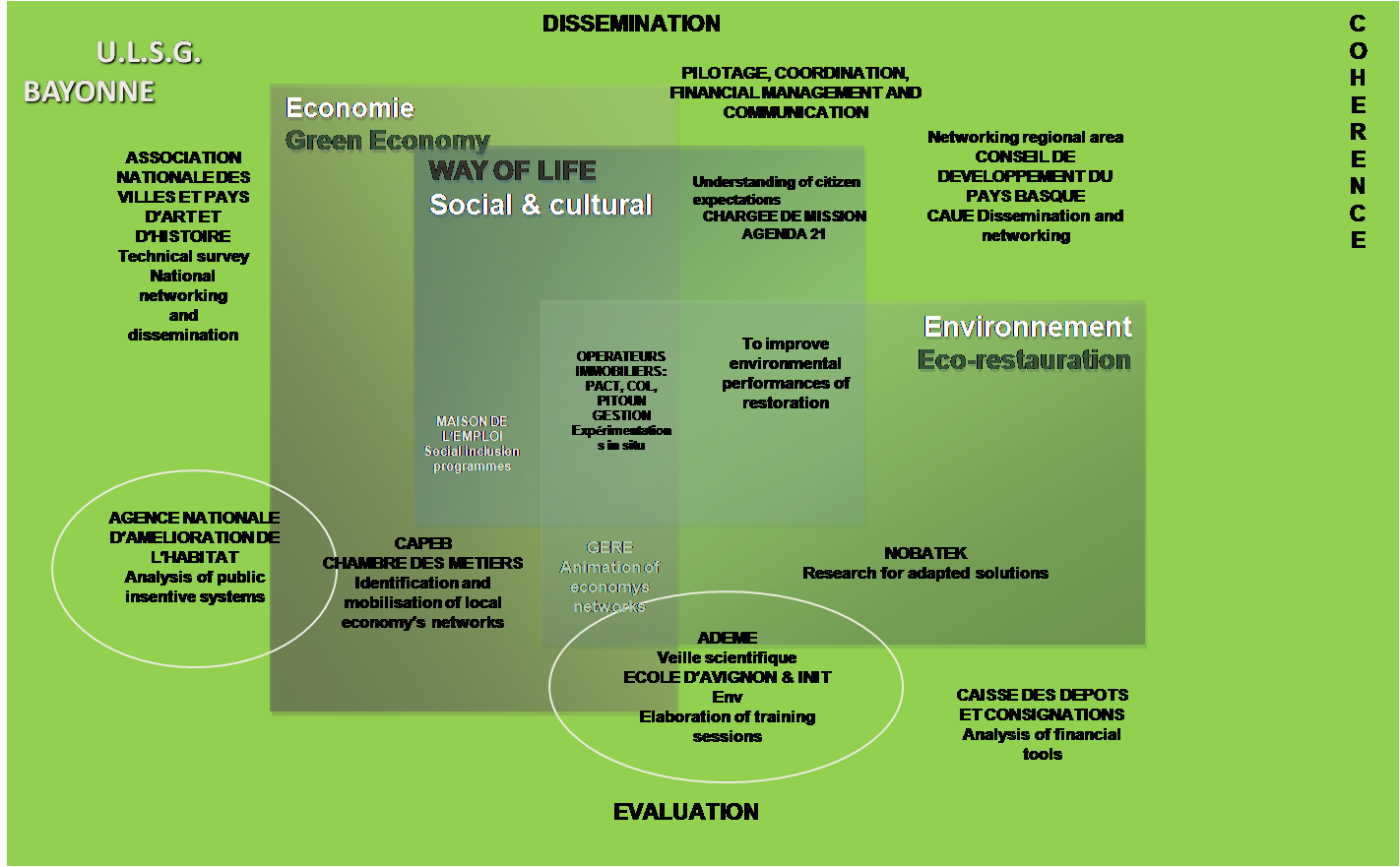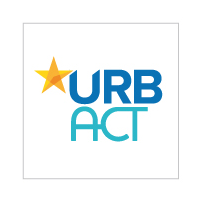Bayonne: Restoring Buildings and Citizen Participation with URBACT
Edited on
24 June 2019Europe’s old towns reflect the continent’s long and articulated history. Their beauty attracts visitors from all over the world, making their dwellers proud of their cultural heritage. However, living in a historical centre is often challenging: poor living conditions inherited from past concepts of urban space and architecture clash with the need for comfort of its inhabitants. The need for sustainability and energetic performance in renovation represents an additional challenge that needs to be coped with. To tackle this challenge, the city of Bayonne (France) decided to embark on an URBACT journey with partners from all over Europe. As part of this experience, the municipality had to gather relevant stakeholders and work with them to draft a local action plan. The Local Support Group set up in this perspective quickly became a driver in mobilizing citizens and local organizations around the “eco-restoration” agenda.

On the western border with Spain, the city of Bayonne (population 46.000 inhabitants) developed until the end of the 19th century as a defence point for France. At the beginning of the 20th century, the city lost its military role: ramparts were destroyed and the city expanded beyond its medieval walls. Yet its original features left a strong imprint on the urban fabric of the historic centre. The area is characterised by a high density of dwellings that are often not respecting the standards for housing: rooms lacking natural light or fresh air, significant noise pollution and fire risk, etc. These features have engendered an important population decrease in the city centre between 1960 and 1990. The number of inhabitants fell under 5.000 in 1990 in the historic area, leaving most buildings totally or partially unused, unmaintained and falling into decay. The population that still live in the city centre is mainly composed of low-income and precarious households. Preserving historic buildings in a sustainable way while offering good living conditions for the inhabitants became a major concern for Bayonne’s city council. The Municipality started to explore the opportunities offered by eco-restoration of ancient buildings, that is environment-friendly techniques to refurbish buildings in a more efficient and sustainable way. While having little experience with European projects, Bayonne decided to take a step further and explore this policy challenge in the framework of the URBACT programme, leading the LINKS network (see below). LINKS – Low tech inherited from the old European cities as a key of performance and sustainability
- Project aim: reconciling patrimonial and environmental qualities to get a sustainable and desirable housing environment in the heart of the cities for a diversified population.
- Partners: Almería (ES), Anderlecht (BE), Bayonne (FR), Brasov (RO), Budrio (IT), Delft (NL), Kilkenny (IE), Veria (EL)
- Duration: July 2010 – February 2013
- Link to the project: http://urbact.eu/links
Sharing knowledge and taking stocks: the added-value of partnership working.
Through working with partners, both at European level with the cities involved in the LINKS network and at local level by involving a wide range of stakeholders in the Local Support Group, Bayonne was able to take key steps in addressing issues related to refurbishing the historical city centre. Aiming at finding the best technical and sustainable solutions that would improve the living conditions of the inhabitants of the city centre, Bayonne initially gave a strong technical dimension to its work within the LINKS network. Bayonne’s Local Support Group was created so as to foster an integrated approach of the issue to be tackled, with 3 sub-groups: social, economic, and environmental. The municipality managed to gather representatives of the department in charge of the local Agenda 21, a local organisation aiming to disseminate information about energy-efficiency (Espace Energie Info), the national agency for habitat improvement (ANAH), the national association of Art and History cities, the Chamber of Craftwork, the Caisse des Dépôts et Consignations – a national bank supporting local development, as well as a number of local associations/ networks of players from the building sector. With respect to this initial period, Marion Thenet, vice-president of the Network of Companies Respecting the Environment and member of the Local Support Group, remembers: “The problem with Bayonne’s Local Support Group at the beginning was that it was not very clear which were our objectives, what we wanted concretely to do. We met and discussed but we did not manage to see what the project would bring in terms of outcomes and final results.” In parallel, Bayonne and all network partners were going through a fundamental step in the URBACT method: the baseline study. To be produced at the very beginning of the network life cycle, the baseline study aims to establish a state of the art regarding the policy challenge addressed by the network and existing knowledge on the topic, as well as partners’ profiles in relation with the policy issue. This initial baseline exercise allowed the network partners to share existing knowledge, studies, practices, etc. on the topic of eco-restoration at a very fast pace. It turned out to be a milestone in Bayonne’s policy approach, when the team realized that what they were no longer in the situation of developing technical solutions for the eco-restoration of their historical city centre, but rather at a stage when they had to embed the knowledge available at European level in their local policy. This was also when the elected representative involved in LINKS at that time, Martine Bisauta, City Councillor for sustainable development and citizen participation, provided a strong road map for the work of Bayonne in LINKS: “Restoring buildings is important, but citizens should come first”. Eco-restoration and building a “future-proof” historical centre were high on the municipality’s agenda. Yet citizens and professionals alike knew very little about it. And they had to be informed! Frédérique Calvanus, Lead partner of the LINKS network in Bayonne’s municipality, and coordinator fo the related Local Support Group, explains this change: “LINKS was no longer about finding the best technical solutions for eco-restoration, but about bringing and disseminating those solutions to all stakeholders, whether they were professionals of restoration, housing engineers within the municipality or inhabitants of the city centre. The challenge for the Local Support Group was then how to do that in an interesting and innovative way.”
The Local Support Group piloting actions to activate inhabitants and key players in the building sector
Concrete ideas and examples came from the URBACT Summer University for Local Support Groups, organized in August 2011 in Krakow, Poland. For the representatives of Bayonne, this event was a fundamental learning experience and a trigger to find innovative solutions for old problems. Frédérique Calvanus, the network leader, felt “authorized” to test things that she had not tested before, to work differently. “For a career in public administration, an event like the URBACT Summer University is a big breath of oxygen”. This resulted into a series of pilot actions dedicated to training and dissemination on eco-restoration approaches and techniques, targeting the different categories of stakeholders. Once successfully tested, these actions would be part of Bayonne’s Local Action Plan. From Marion Thenet’s point of view, this is the key success factor of the URBACT local support group in Bayonne: “ I participated in many similar groups where there was a lot of blah blah, but then nothing happened. I chose to play an active role in Bayonne’s ULSG because we did concrete things for the community, in an innovative and appealing way. And it worked!” Pilot actions were then initiated by the Local Support Group, aiming to outreach to inhabitants and different players in the chain of the “eco-restoration agenda”. Thematic Cafés were organised, building on the “Cultural Heritage Boutique” experience, a documentation center providing technical support to citizens for the preservation of historic buildings also member of the Local Support Group. In order to address the supply-side of eco-restoration, craft persons were invited to explain the benefits of this approach to renovation. The Local Support Group organised very concise modules for craft persons and workers in the building sector early in the morning, before they would go to work. Specific techniques and materials were introduced by experienced professionals depending on the theme of the Café.
The lack of specific training was also identified as an obstacle to foster the “eco-restoration” agenda. The Local Support Group thus organised a number of training seminars, Journées Form’action, combining theoretical modules and exchange on concrete hands-on cases. Through these seminars, the municipality raised awareness, among professionals of the construction sector, about the added-value of training, and at the same time, managed to involve stakeholders that are often difficult to reach. All these initiatives could be launched thanks to new partnership dynamics emerging in the Local Support Group, building on members’ experience, knowledge and know-how. The ULSG became a sort of living lab. Nicolas Duvallet, representative of Espace Info Energie in the Local Support Group considers this collaborative dimension as one of the main added-value of the URBACT experience: “The structure for which I work does a lot of animation for the general public in the field of energy efficiency and sustainable living. Through the Local Support Group set up for the LINKS network, I discovered the added-value of partnership, working together to do something bigger. Before we each worked alone, now we collaborate to do things better, inform more people, touch new categories of stakeholders!” Marion Thenet appreciated the piloting approach: “Bayonne ULSG managed to find new and innovative ways to communicate to the public. We organized more events because the pilot initiatives brought very good results. Our first “Positive Energy Day” attracted many participants despite the heavy rain and… a general lack of interest among the public about energy efficiency. With the actions implemented thanks to the LINKS network, Bayonne managed to reverse that trend! ”
A networking experience that brought tangible results

As a result of the LINKS experience, Bayonne has produced an Action Plan for the eco-restoration of its historical center that is aligned with the primary stakeholders needs in this respect. Moreover, pilot actions have been tested, enhanced and implemented. With the involvement of citizens and users through the actions of the Local Support Group, Bayonne Municipality is now recognized as a legitimate driving force in this field. Marion Thenet reckons: “The involvement in LINKS changed a lot the way the Municipality was perceived. The message they conveyed through this project is that they wanted to do things together with the citizens, for them, concrete and positive actions.”
Being part of a European project brought change in the team working in the municipality. Partners working together in an enlarged pool of stakeholders allowed for a more transparent, open and participative approach: “The Municipality was able to de-cluster its activities in the name of a European project. We diversified our actions in the field of eco-restoration (working on topics not within the direct institutional competence of the Municipality, for example training, facilitating a participatory dynamic)” Frédérique explains. This bear fruit for other projects as well!
Until not so long ago, the use of Public Spaces in the city centre was a very delicate issue for the Municipality, with divergent, contrasting positions among Municipality Services themselves. Using the URBACT experience in terms of participatory approach and partnership working, a round table was created on the topic. “We started by saying that no position is wrong”, explains Frédérique. Next, by applying the URBACT Method, the Municipality commissioned two external experts (an architect and a sociologist) to draw a baseline study on this topic. This allowed all services to share a common background and better evaluate their positions. They started to work together on this study in order to build an internal integrated approach on the topic, both in terms of analysis (use and appropriation of public space) and of projects (what kind of projects can be proposed in order to animate it and involve citizens).
Overall, the Bayonne case proves that all members involved in the ULSG have something to win: enlarging their network and learning to work in partnership, as well as participating in concrete actions or improving the institution’s image. Besides, the LAP is being implemented partly though Municipality’s funds.
By its implication in URBACT, Bayonne accepted a major challenge: lead a network of European cities in order to improve quality of life in old centres and create comfortable and sustainable housing. Along the way, the project was not only restructured from scratch but a new participatory dynamic was created among local stakeholders. Building on this experience, Bayonne is now steadily moving forward!
LINKS network Results - URBACT website
Zoom on Bayonne - URBACT website
LINKS project mini-site - URBACT website  - Project document
- Project document
 Submitted by URBACT on
Submitted by URBACT on





